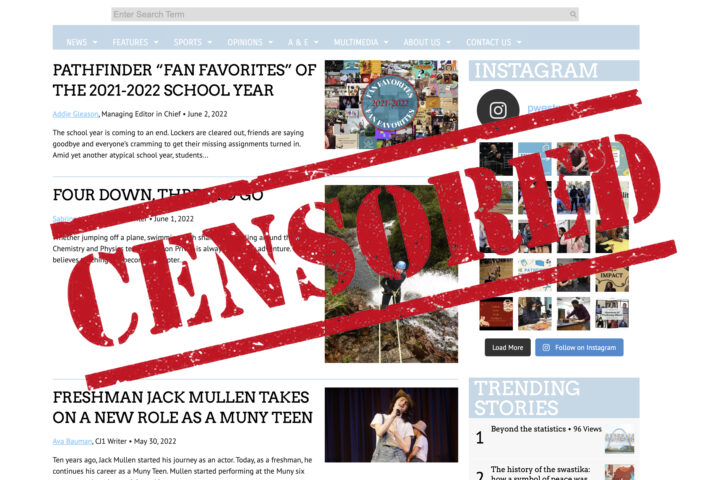History is full of rules and codes that were invented for one reason and maintained for another. Rules can be a good thing as long as they are protecting people from hurting themselves and others. The problem arises when society clings to rules that are outdated.
Dress codes tell people they need to hide parts of their bodies that could be perceived as “sexual.” Just as other rules and standards have gone out of fashion because of their background in oppression, it’s time for traditional dress coding to end. These rules and regulations have no place in the present day and no room for the future.
When I was in middle school, my teachers would dress code me every week for shorts being too short, shirts not covering enough of my legs? when I wore leggings, or being able to see my midriff when I lifted my arms. But the worst was getting dress coded because my bra straps were visible. When a sixth grade girl is told she has to change clothes or go home because she’s not covering enough of her body, she is not being taught to embrace herself for who she is but rather to be ashamed.
The idea of dress code is a widely debated topic, so deeply ingrained in our systems that it’s hard to pluck out. One argument that many schools use for promotion of dress code is the idea that it prepares you for “the real world” and “student’s future jobs.” There is an assumption that schools make that jobs and careers will be the exact same as they were 30-40 years ago when the generations before us were entering the workforce. But this assumption is not true. There has been so much cultural shift within the last decade. Jobs are starting to toss aside the traditional, and even archaic, models of work. Businesses are meant to better society, and young people want more and more to feel as if they are contributing in a meaningful way rather than just making a quota. Things are becoming more relaxed and more efficient. The basic 9-5 desk job isn’t the norm anymore. So the way we are treating dresscode shouldn’t be either.
Companies have been addressing the issues that have been arising with dress coding at work. Goldman Sachs is one example of a company that recently relaxed its dresscode to fit a more relaxed environment. In July of 2017, both Democratic and Republican Congressional women protested the ban of sleeveless shirts and dresses. It started when a young reporter was barred from entering the Speaker’s Lobby because her dress did not cover her sleeves and was deemed inappropriate. She quickly improvised and “ripped out pages from her notebook and stuffed them into her dress’s shoulder openings to create sleeves.” When trying to enter again, the guard rebuffed her insisting that her creation was still unacceptable.
In school, enforcers say dress codes prevent students from getting “distracted.” By students, they are talking about boys. Even if young boys are somehow unable to learn when a classmate is wearing spaghetti straps, it is on the boy to deal with his own impulses, not the girl he’s staring at. But chances are a fourth grade boy isn’t too concerned with his classmate’s spaghetti strap. If children grow up learning that women need to “cover up” we will become adults programmed to objectify women.
Dress coding perpetuates rape culture, beginning in a child’s first years at school. When a girl comes to class wearing a shirt that is exposing her midriff or shorts that are too short and she is told that she needs to leave class and go change so that it does not distract the boys, that is telling her one thing: her education is not as important as it is for those boys. She doesn’t just get to go to school and learn. What she puts on her body comes first. And it’s showing boys that they are allowed to evaluate a woman based on what she is wearing.
The ridiculous notion that we need to cover up girls so boys don’t get distracted or have sexual feelings clings onto the gender stereotypes. If people think “being a boy” means that it is okay to objectify women and get in their space without consent, they are entirely incorrect. Men and boys should be held to higher standards. Instead of blaming the girls for the boys lack of self control, we need to hold them accountable for their actions and words. Sexual assault culture is not just something you hear about from far away, it permeates our government, our work places, and our schools. Teaching students that women need to change and not men is unacceptable. A few years ago, the University of Kansas set up an art gallary to “shatter the myth that sexual violence is caused by a person’s wardrobe.” This exhibit shows 18 outfits hanging next to rape survivor’s stories. The outfits were based on the survivor’s description. One of the stories read “A sundress,” … hanging next to a tiny pink, red and white striped dress. “Months later my mother would stand in front of my closet and complain about how I never wore any of my dresses anymore. I was 6 years old.” Society is sick to believe that it is somehow the victim’s fault based on the clothes they were wearing. A woman should be able to walk around completely naked and society should still be aware of the fact that she is not “asking for it.” All of these beliefs that women should be blamed for “tempting” the man begin when you’re just a child. When students watch their female peers get reprimanded for showing a part of their body that teachers decide is unacceptable, they are unconsciously learning to see women as sexual objects rather than a full person with a heart and a mind. Not only does dress code inherently blame victims, it also hypersexualizes young females.
And it isn’t as though girls are going out of their way to find clothes that don’t fit the dress code. Take a look in any box store selling children’s clothes, and you will see how hard it is to find shorts that reach your fingertips. However in a boys clothing department nearly every item, if not every single one, will meet the dress code. It’s time for schools to catch up with the rest of the world and realize that these clothes are not “scandalous,” they’re not only normal but they’re the most accessible clothes. No young girl sees what she is wearing as a problem until someone else makes it a problem.
Now, I go to a school with a relaxed dress code. Nobody takes any notice when someone wears a crop top, because it’s not seen as anything remarkable. It holds no significance, and this environment is so much healthier than dress code-strict schools.
In addition to being a social issue, dress coding is inherently undemocratic. Schools should of course enforce a federal law against indecent exposure, but not a set of rules that tries to cover up more than the law requires. Some argue that if there is no dress code, how do schools stop kids from wearing clothing with racial slurs and inappropriate language? The answer is simple. That is a language issue, and should not be seen as a clothing one. A school can still prevent students from wearing offensive words/phrases to school because it is bullying and distrespecting people based on their race/sex/sexual orientation. When this problem arises, it really isn’t because of the type of clothes they are wearing. It is because of the words on the clothes, thus breaking the code of conducting oneself and hurting others. This is different from wearing something deemed “inappropriate.”
So where does the undemocratic part come in? If dress code is more than just a law keeping people from running around naked, then it violates the 1st amendment. The first dress code law was established by the Supreme Court in 1969. The trial involved several highschool students who wore black armbands in protest of the Vietnam War. The students won. This case, also known as Tinker v. Des Moines Independent School District, ruled that students do not “shed their constitutional rights to freedom of speech or expression at the schoolhouse gate.” This case is not different from one regarding a student wearing something deemed “inappropriate.” Private schools are allowed to do what they want in regards to dress code, but just because something is technically legal to enforce, that does not mean it is right.
The idea of dress coding has long passed its expiration date, so why haven’t we tossed it out yet? Currently in today’s social climate women are desperately fighting over the right to their own body, children are being gunned down at schools where they are supposed to be safe, one in six women are victims of an attempted or completed rape in their lifetime, and black teenagers are being killed by the police for the color of their skin. So the question arises; why, after everything that has happened and all the things that schools could be doing, are they still sitting around trying to hold onto dress codes? It is because of the patriarchal idea that women should be ashamed of their bodies.



